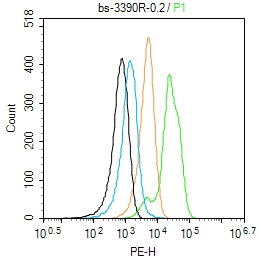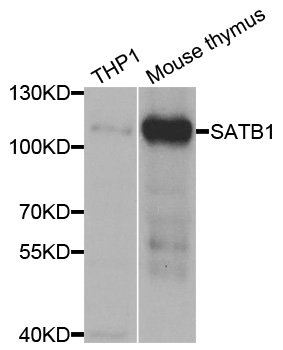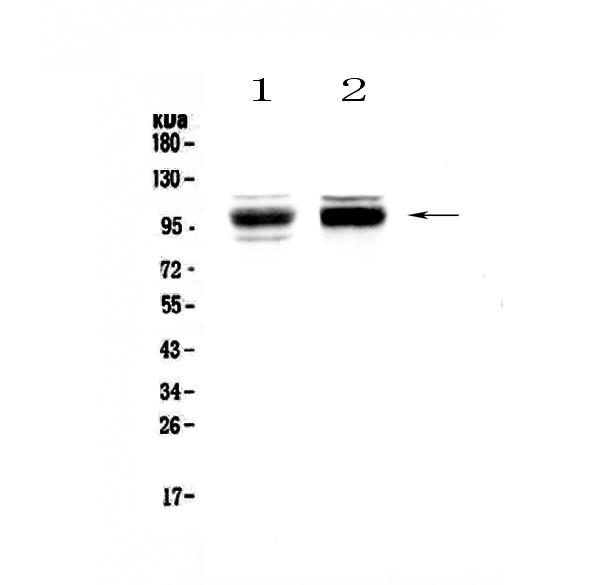![IHC-P analysis of endometrium tissue using GTX83684 SATB1 antibody [10G2]. Antigen retrieval : Heat-induced epitope retrieval by 10mM citrate buffer, pH6.0, 100oC for 10min. Dilution : 1:50 IHC-P analysis of endometrium tissue using GTX83684 SATB1 antibody [10G2]. Antigen retrieval : Heat-induced epitope retrieval by 10mM citrate buffer, pH6.0, 100oC for 10min. Dilution : 1:50](https://www.genetex.com/upload/website/prouct_img/normal/GTX83684/GTX83684_1703_IHC-P_w_23061420_272.webp)
IHC-P analysis of endometrium tissue using GTX83684 SATB1 antibody [10G2]. Antigen retrieval : Heat-induced epitope retrieval by 10mM citrate buffer, pH6.0, 100oC for 10min. Dilution : 1:50
SATB1 antibody [10G2]
GTX83684
ApplicationsImmunoFluorescence, Western Blot, ImmunoCytoChemistry, ImmunoHistoChemistry, ImmunoHistoChemistry Paraffin
Product group Antibodies
TargetSATB1
Overview
- SupplierGeneTex
- Product NameSATB1 antibody [10G2]
- Delivery Days Customer9
- Application Supplier NoteWB: 1:500. ICC/IF: 1:100. IHC-P: 1:50. *Optimal dilutions/concentrations should be determined by the researcher.Not tested in other applications.
- ApplicationsImmunoFluorescence, Western Blot, ImmunoCytoChemistry, ImmunoHistoChemistry, ImmunoHistoChemistry Paraffin
- CertificationResearch Use Only
- ClonalityMonoclonal
- Clone ID10G2
- Concentration0.8 mg/ml
- ConjugateUnconjugated
- Gene ID6304
- Target nameSATB1
- Target descriptionSATB homeobox 1
- Target synonymsDEFDA, DHDBV, KTZSL, DNA-binding protein SATB1, special AT-rich sequence binding protein 1 (binds to nuclear matrix/scaffold-associating DNA)
- HostMouse
- IsotypeIgG1
- Protein IDQ01826
- Protein NameDNA-binding protein SATB1
- Scientific DescriptionCrucial silencing factor contributing to the initiation of X inactivation mediated by Xist RNA that occurs during embryogenesis and in lymphoma (By similarity). Binds to DNA at special AT-rich sequences, the consensus SATB1-binding sequence (CSBS), at nuclear matrix- or scaffold-associated regions. Thought to recognize the sugar-phosphate structure of double-stranded DNA. Transcriptional repressor controlling nuclear and viral gene expression in a phosphorylated and acetylated status-dependent manner, by binding to matrix attachment regions (MARs) of DNA and inducing a local chromatin-loop remodeling. Acts as a docking site for several chromatin remodeling enzymes (e.g. PML at the MHC-I locus) and also by recruiting corepressors (HDACs) or coactivators (HATs) directly to promoters and enhancers. Modulates genes that are essential in the maturation of the immune T-cell CD8SP from thymocytes. Required for the switching of fetal globin species, and beta- and gamma-globin genes regulation during erythroid differentiation. Plays a role in chromatin organization and nuclear architecture during apoptosis. Interacts with the unique region (UR) of cytomegalovirus (CMV). Alu-like motifs and SATB1-binding sites provide a unique chromatin context which seems preferentially targeted by the HIV-1 integration machinery. Moreover, HIV-1 Tat may overcome SATB1-mediated repression of IL2 and IL2RA (interleukin) in T-cells by binding to the same domain than HDAC1. Delineates specific epigenetic modifications at target gene loci, directly upregulating metastasis-associated genes while downregulating tumor-suppressor genes. Reprograms chromatin organization and the transcription profiles of breast tumors to promote growth and metastasis.
- Storage Instruction-20°C or -80°C,2°C to 8°C
- UNSPSC12352203

![WB analysis of HEK293T cells transfected with SATB1 plasmid (Right) or empty vector (Left) for 48 hrs using GTX83684 SATB1 antibody [10G2]. Loading : 5 ug per lane WB analysis of HEK293T cells transfected with SATB1 plasmid (Right) or empty vector (Left) for 48 hrs using GTX83684 SATB1 antibody [10G2]. Loading : 5 ug per lane](https://www.genetex.com/upload/website/prouct_img/normal/GTX83684/GTX83684_3817_WB_w_23061420_904.webp)
![ICC/IF analysis of COS7 cells transiently transfected with SATB1 plasmid using GTX83684 SATB1 antibody [10G2]. ICC/IF analysis of COS7 cells transiently transfected with SATB1 plasmid using GTX83684 SATB1 antibody [10G2].](https://www.genetex.com/upload/website/prouct_img/normal/GTX83684/GTX83684_770_ICCIF_w_23061420_116.webp)
![ICC/IF analysis of HT29 cells using GTX83684 SATB1 antibody [10G2]. ICC/IF analysis of HT29 cells using GTX83684 SATB1 antibody [10G2].](https://www.genetex.com/upload/website/prouct_img/normal/GTX83684/GTX83684_771_ICCIF_w_23061420_428.webp)





![FACS analysis of Jurkat cells using GTX83679 SATB1 antibody [11E8]. Red : Primary antibody Blue : Negative control antibody](https://www.genetex.com/upload/website/prouct_img/normal/GTX83679/GTX83679_114_FACS_w_23061420_140.webp)
![IHC-P analysis of breast adenocarcinoma tissue using GTX83682 SATB1 antibody [13D6]. Antigen retrieval : Heat-induced epitope retrieval by 10mM citrate buffer, pH6.0, 100oC for 10min. Dilution : 1:50](https://www.genetex.com/upload/website/prouct_img/normal/GTX83682/GTX83682_1694_IHC-P_w_23061420_972.webp)
![WB analysis of HEK293T cells transfected with SATB1 plasmid (Right) or empty vector (Left) for 48 hrs using GTX83685 SATB1 antibody [6C6]. Loading : 5 ug per lane](https://www.genetex.com/upload/website/prouct_img/normal/GTX83685/GTX83685_3818_WB_w_23061420_452.webp)